Nurse-call technologies evolve to improve care
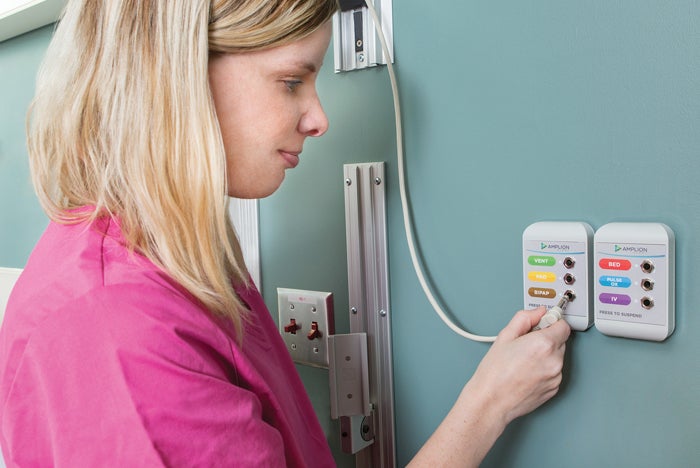
Photo courtesy of Amolion
Nurse-communication systems have evolved to address patient- and staff-flow issues in innovative ways, resulting in improved patient satisfaction, staff communications and operational efficiencies.
The latest systems facilitate patient-to-staff voice communications, assimilation with real-time locating systems (RTLSs) and integration with electronic health records and admitting, discharge and transfer.
In light of these advances, administrators are looking for more integration with real-time algorithms that provide applications on mobile devices securely. Also, they want solutions that are adaptable, user-friendly and easy to support.
Smartphone connections
Many nurse-communication systems are being used with smartphones and other hand-held devices. In such cases, choosing the proper mobile-device solution is important. “To get the full value from the integration between nurse-call and wireless phones, nurse managers should start with an assessment of desired workflow and use cases,” comments Julie Brown, institutional market leader, Johnson Controls, Milwaukee, Wis.
Additionally, nurse leaders must look at the broader picture, according to Rhonda Collins, R.N., chief nursing officer, Vocera Communications Inc., San Jose, Calif.
“Smartphones are part of that picture, but they are not the total solution,” Collins notes. “It is important to provide nurses and other team members with options, so they can choose the best device for their particular need. In a fast-paced, hands-on environment, many nurses still prefer using a hands-free communication device.”
Among the many mobile innovations in this area, the Tek-CARE Staff app from TekTone Sound & Signal Mfg. Inc., Franklin, N.C., allows staff members to view and interact with calls on iOS and Android devices. Health care staff can receive and send calls while away from the nurse station.
Hill-Rom, Chicago, has introduced LINQ mobile, a smartphone app designed to improve communication and collaboration. The mobile app allows teams to connect with each other, their patients and patient information in real time. “The LINQ mobile app couples secure voice and text communication with nurse-call, electronic health records, real-time locating and staff-directory integrations so that caregivers have access to patient information, patient needs and staff availability where and when they need it,” says Paul Johnson, senior vice president and president of patient support systems.
Jeron Electronic Systems Inc., Niles, Ill., offers the Noti-Fi smartphone app, the latest addition to its Pro-Alert and Provider family of nurse-call systems. A tone or vibration alerts staff to a new resident or patient call; it also displays the room number, type of call priority and length of time the call has been active. “Noti-Fi is flexible, scalable and leverages the technology that facilities already have in place. No cellphone data are required because call notifications are sent over the existing Wi-Fi LAN,” says Myles Cochran, director of marketing.
Amplion Alert from Amplion Clinical Communications, Nashville, Tenn., has built-in messaging software that communicates nurse-call requests, alarms, rounding and turns directly to the caregiver’s smartphone. “The data captured by the software (on caregiver response time) are made available through real-time reports to nursing leadership, to help monitor and improve workforce efficiency, such as identifying rooms that require more time from the caregiver and adjusting room assignments,” says Frank Grant, president and CEO.
Other interfaces
Additionally, more nurse-communication systems are interfacing with medical equipment, RTLSs and “internet of things”-enabled devices.
For example, Amplion Alert interfaces with medical devices for alarm management with RTLS badges to instantly capture data on patient-room activity as caregivers enter the room, with clinical communication devices (such as Waltham, Mass.-based Mobile Heartbeat, with which Amplion has a technology partnership) and with smart beds to communicate those alarms to caregivers. Because the system is built on an interoperable platform, it can integrate with any internet-enabled device.
Nurse-communication systems have evolved to address patient- and staff-flow issues as well. West-Com Nurse Call Systems Inc., Fairfield, Calif., offers workflow applications that allow health care staff to communicate easily with other departments. For example, by pressing a button on a workflow station outside a patient’s room, the care team can request environmental services personnel to clean the room. “Our solution also can report the current census of a unit and the number of patients waiting for a bed,” says Marc Peters, director of marketing.
The right nurse-communication system can improve clinical workflows as well. Collins offers this example: The team at Hardin Memorial Health, Elizabethtown, Ky., is using a hands-free communication system to provide nurses and other team members with the resources they need before trauma patients arrive. When an emergency medical service provider notifies the emergency department of the arrival of an ambulance carrying a critical patient, the call recipient can broadcast a message to a code team. Care team members assigned to the code receive the alert on their wearable badges and quickly proceed to the trauma room.
Workflow analysis is required to determine which technologies will address the needs of a hospital, including patient and staff-flow issues, adds Brown. “Dedicated hardware devices can be installed throughout the facility with meaningful applications to include transport, environmental services, pharmacy, labs and rounding notifications,” she says. “Wireless phones also can be implemented to improve caregiver response times to patient requests.”
Other features
Nurse-communication systems recently introduced to the health care market incorporate many other features.
Cornell Communications Inc., Milwaukee, offers mobile handsets via a product called “inform.” It notifies staff when a call has been taken, by whom and for what reason the patient or resident needs assistance. This avoids redundant responses to calls for assistance; it also captures and tabulates call frequency, duration and responsiveness of care staff.
One challenge that manufacturers face is creating a look that blends with the interior of a health care facility while maintaining functionality for staff. To that end, TekTone recently introduced the NC415A Nurse Call Master Station. It is small, discreet and features a touchscreen that facilitates easy staff interaction. Available in voice and non-voice versions, it utilizes minimal wiring.
West-Com’s Unit CareBoard provides live actionable metrics on the nursing unit, which allows nurse managers to quickly identify potential quality-of-care issues and make the necessary adjustments. It also informs team members about patient allergies, precautions or current status in strategic locations to ensure a high level of care.
The West-Com system also allows hospitals to actively involve patients and their families in patient care plans. It displays information on common care questions, which can include mobility, medications, allergies, care goals and an anticipated discharge date. “This not only reduces anxiety levels caused by lack of knowledge, it also provides an opportunity for patients and family members to review the care plan for accuracy,” Peters says.
Vocera Communications Inc. has introduced an analytics solution that aggregates data on how and when nurses communicate. Intuitive dashboards and reports provide insight into the number of calls, texts, alarms and alerts that clinicians receive. This data can help managers diagnose workflow trends, identify root causes of sentinel events, and improve operational and clinical efficiencies. Also, understanding the frequency and volume of alerts can inform the way communication workflows should be redesigned to improve response times.
Jeron Electronic Systems Inc. recently developed its Provider solution for ambulatory care. Designed for clinic and ambulatory surgery settings, Provider 790 for clinics improves clinician workflow by queuing patients and providers, thereby minimizing wait times. It also provides a complete view of all clinic activity via wall-mounted PC consoles.
Finally, the Amplion Alert combines nurse-call capabilities, alarm management and messaging into a unified solution that requires no middleware. Nurse-call and device alarms are delivered directly to the appropriate caregiver’s phone for quick response and to minimize nuisance alarms. Talkback capability allows the caregiver to communicate immediately with the patient from the bed, chair or bathroom. If the assigned caregiver is unable to address the need, the alarm can be forwarded to the next assigned caregiver.
By incorporating clinical delays into each alarming device, the system helps reduce false positive alarms that distract and wear down nurses. When caregivers receive a message on their phones, they know that the alarm has been going off for an “X” period of time, that it is indeed their patient, and that the alarm needs their attention.
Fighting fatigue
As technology has progressed, more in-room devices and systems are able to send data directly to nurses and the associated care team, sometimes overwhelming busy caregivers.
To overcome this hurdle, Hill-Rom has developed a clinical communication platform that addresses alarm fatigue in two ways. First, Hill-Rom provides evidence-based best practices for alarm annunciation and routing, and then allows for site-specific customization to ensure that caregivers are informed as they deliver patient care. Second, the system can integrate with third-party middleware that provides additional alert and alarm-management capabilities.
TekTone’s Tek-CARE400 P5 nurse-call system features selectable and customizable tones that allow nurse managers to create unique and diverse call types. This prevents alarm fatigue often created by the same tones being repeated over and over. The company’s Nurse Call Master Station also features adjustable volume across the platform.
GE Healthcare, Chicago, offers a digital centralized monitoring unit that features Alarm Spotlight, which allows clinicians to see what the alarm burden is for multiple- or single-care units as well as down to the bed level. “The system has a 15-minute latency that allows the clinician to quantify and adjust unit alarms to reduce alarm burden,” says Ajay Parkhe, general manager of monitoring solutions.
Another element of the digital, centralized monitoring unit enables data from different hospital systems, such as bedside monitors, to be visible to caregivers across the enterprise system. This gives caregivers a comprehensive view of the patient at that moment in time, which can lead to faster treatment decisions. A final element enables clinicians to communicate and collaborate securely via voice and text on smartphones.
Proactive and predictive
Grant believes that nurse-communication systems will continue to evolve as intelligent components of real-time patient care delivery systems. “They will become more proactive and predictive — able to anticipate patient needs and help support more efficient workflow, thereby reducing cost and improving patient outcomes,” he says.
Neal Lorenzi is a freelance writer based in Mundelein, Ill.
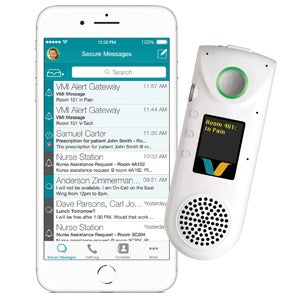
Privacy protection
The Collaboration Suite enables secure messaging, contextual alerts and voice calls. Vocera Communication Inc.
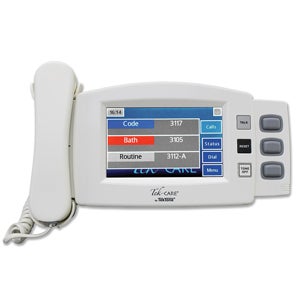
Central system
The Tek-CARE160 nurse-call system features a color touchscreen master station and control panel. TekTone Sound & Signal Mfg. Inc.
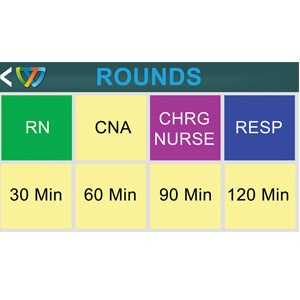
Quick snapshot
West-Com’s Workflow station displays rounding time options for the patient care team. West-Com NCS

Consistent tracking
Mobile handsets capture and tabulate call frequency, duration and responsiveness of care staff. Cornell Communications Inc.
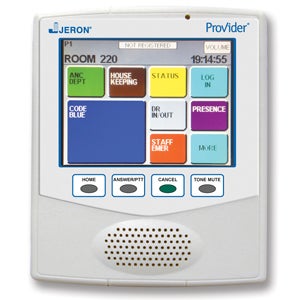
Flowing together
The Provider family of nurse-call systems offers customizable workflows that help acute and ambulatory surgery centers streamline staff and patient flow. Jeron Electronic Systems Inc.
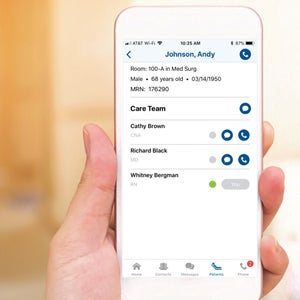
An app for that
LINQ mobile app couples secure voice and text communication with nurse-call, electronic health record, real-time locating and staff-directory integrations. Hill-Rom

Maximized potential
The Telligence Nurse Call Communication System boosts productivity by connecting the nurse-call and clinical workflow. Johnson Controls



